Whether you manage a backyard pool or a large hotel facility, pool safety isn’t optional – it’s lifesaving. Every year, over 4,500 people in the U.S. die from drowning, and thousands more suffer nonfatal injuries, often due to preventable hazards like faulty barriers, poor supervision, or equipment failures (CDC, 2024).
This pool safety checklist combines the most important pool safety rules and swimming pool safety tips to help you create a safer environment for every swimmer. It’s designed to help you stay proactive—verifying every safety layer, from gates and alarms to chemical storage and emergency equipment.
The guide below breaks down 13 essential pool safety categories, aligning with CDC, CPSC, and ASTM International standards, so you can confidently protect swimmers and meet compliance requirements.
Tip: You can download the printable Pool Guard™ pool safety checklist as a free companion tool to this article for ongoing inspections.
A proper isolation barrier is the most critical layer of protection against child drownings. The CDC reports that a four-sided pool fence can reduce drowning risk by 83% compared to open access.

Tip: Local codes may vary. Always verify clearance and latch requirements before installation.
Pro tip: Add gate alarms or magnetic self-latches for extra security. Many local codes follow ASTM F2286 standards for pool fencing.
Even the safest pool design fails without active supervision. In 69% of child drownings, a parent or caregiver was nearby but distracted (CPSC, 2023).
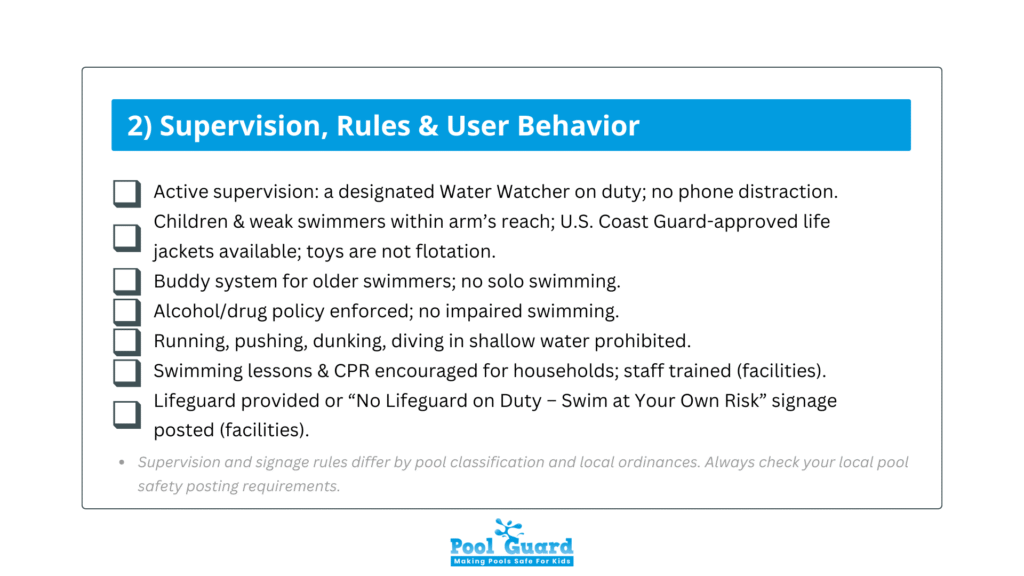
Tip: Train family members or staff in CPR and first aid-the average drowning victim can suffer brain damage in just 4–6 minutes without oxygen.
Alarms and covers add extra seconds – often the difference between prevention and tragedy. The CPSC’s Safety Barrier Guidelines stress using multiple “layers of protection.”
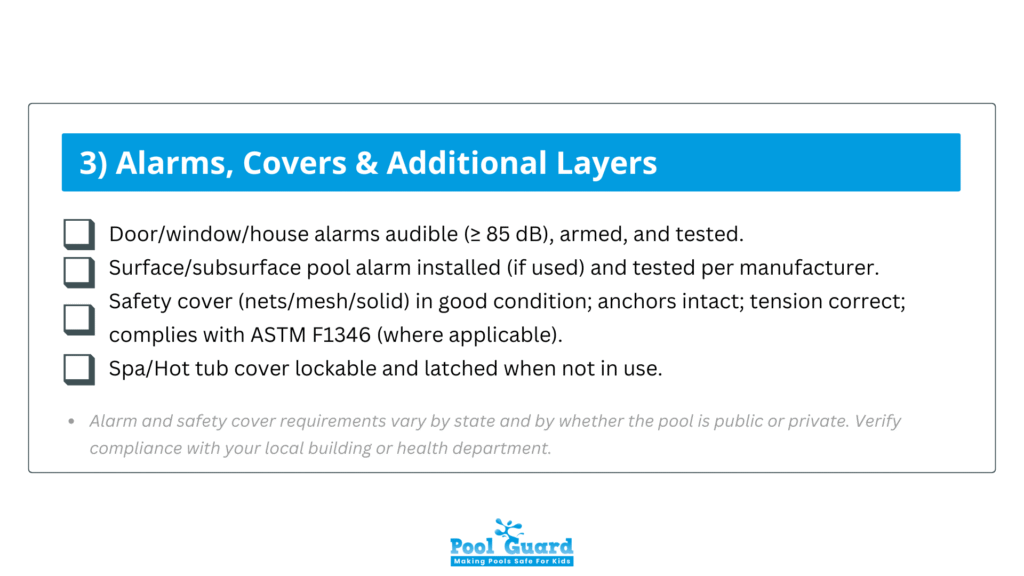
Tip: Check alarm batteries monthly and replace safety cover tension straps annually.
Suction entrapment is rare – but deadly. The Virginia Graeme Baker Pool & Spa Safety Act mandates specific drain and circulation safety features to prevent accidents.

Tip: Residential pools should still meet VGB standards even if not required-entrapped hair or limbs can trap even adults under strong suction.
Clear water isn’t just aesthetic – it’s critical for visibility and sanitation. According to the CDC Healthy Swimming Program, 1 in 8 public pools is closed each year due to chemical or filtration violations. Poor clarity can conceal hazards or drowning victims beneath the surface.
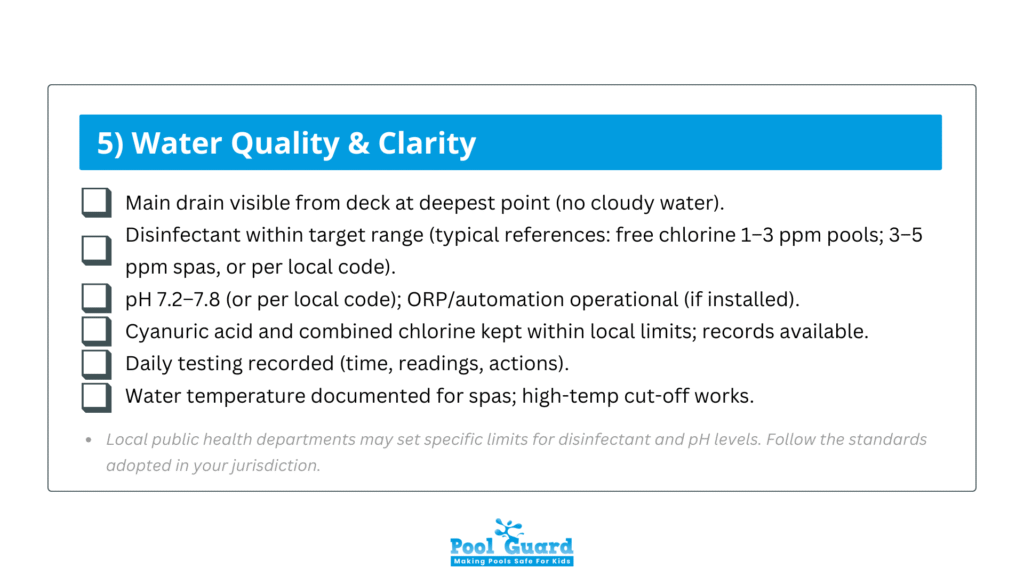
Tip: Public health departments may impose stricter ranges – always reference your local code.
Stat check: In Florida, 23.4% of public pool/spa inspections in 2024 were unsatisfactory (Florida Health CHARTS, based on 25,513 unsatisfactory results out of 109,211 inspections in 2024.).
A safe deck prevents slips, falls, and head injuries – some of the most common non-fatal pool-related accidents. The National Safety Council identifies deck surface condition and lighting as top contributors to these incidents.
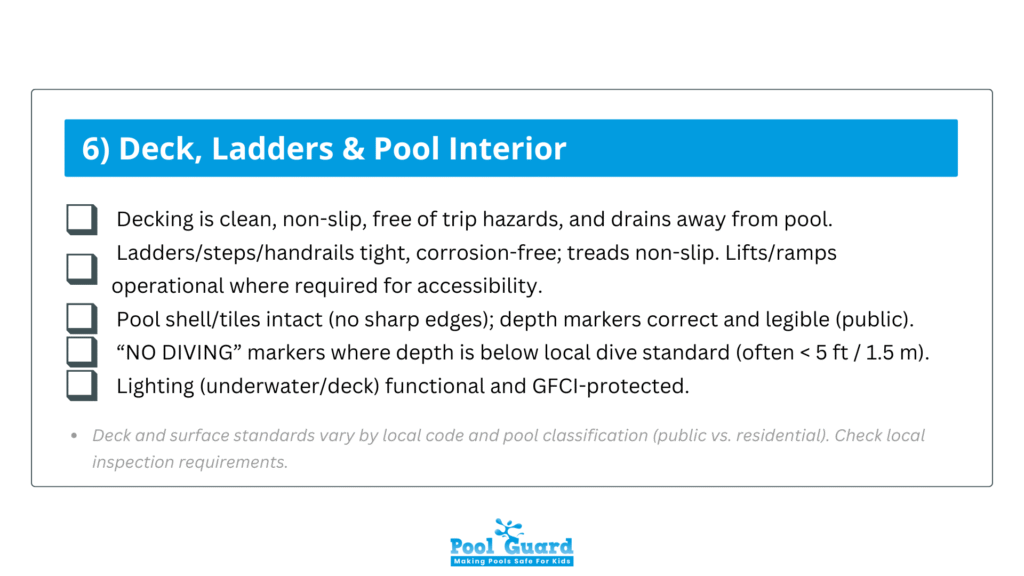
Tip: Deck standards differ for public vs. residential pools. Check local inspection codes.
Pro tip: For ADA compliance, ensure lifts or ramps are functional and regularly tested.
When seconds count, accessibility saves lives. The American Red Cross recommends that all pool facilities – residential or public – maintain reachable and functional rescue gear at all times.
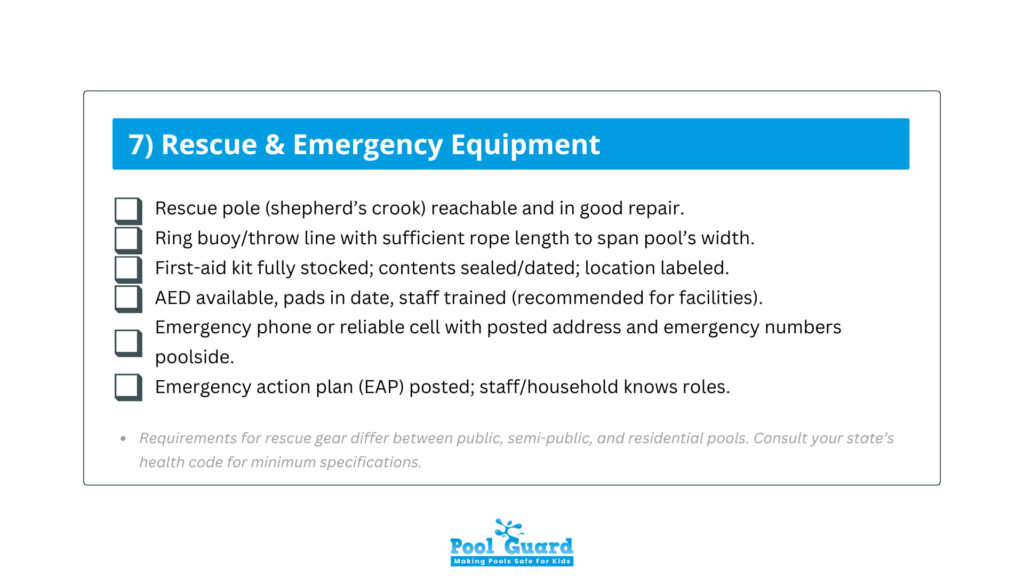
Tip: Rescue gear requirements differ by pool type – always consult your local health code.
Improper storage of chlorine and acids can cause toxic gas leaks or fires. In 2023 alone, the CPSC reported over 3,000 pool chemical–related injuries treated in U.S. emergency rooms – most due to improper handling.

Tip: Compliance may fall under OSHA, NFPA, or state fire safety codes – always cross-reference applicable regulations.
Clear, visible signage is both a legal requirement and a powerful preventive tool. A U.S. case series examining diving-related spinal cord injuries found that warning signs were missing in 87% of incidents, and depth indicators were absent in 75%. These findings highlight how inadequate or missing pool signage can directly contribute to serious, preventable injuries.
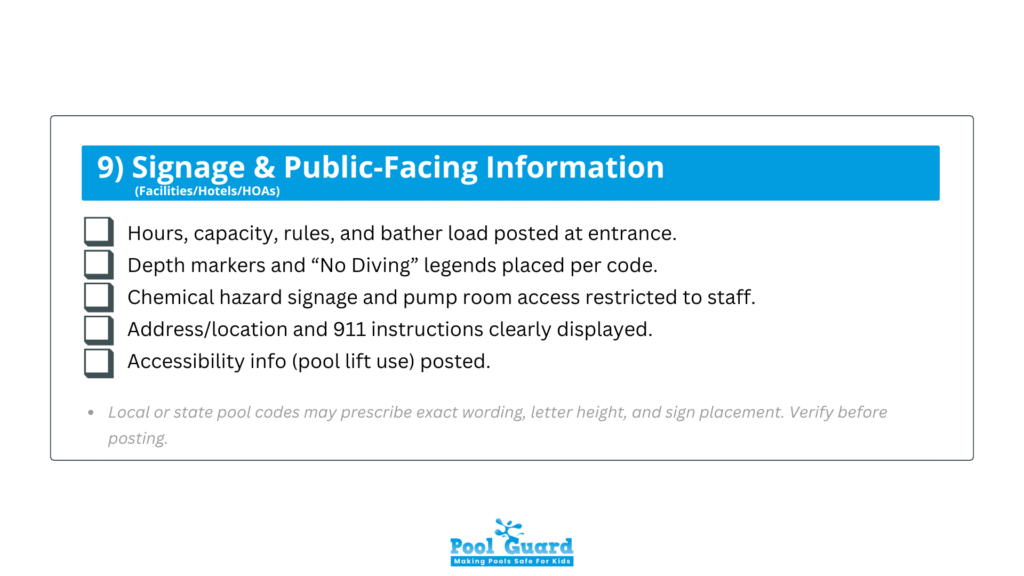
Tip: State laws may specify exact sign dimensions and placement – verify before printing or mounting.
Pro tip: Use durable, weather-resistant signs with 4-inch letters for visibility. Many states specify wording and font size-always confirm before printing.
According to the U.S. Consumer Product Safety Commission (CPSC), 33 fatalities involving electrocution in swimming pools and spas were reported between 2002 and 2018, with many linked to faulty wiring or electrical equipment near the water. Proper grounding and bonding are cited as critical safety measures to prevent such incidents.
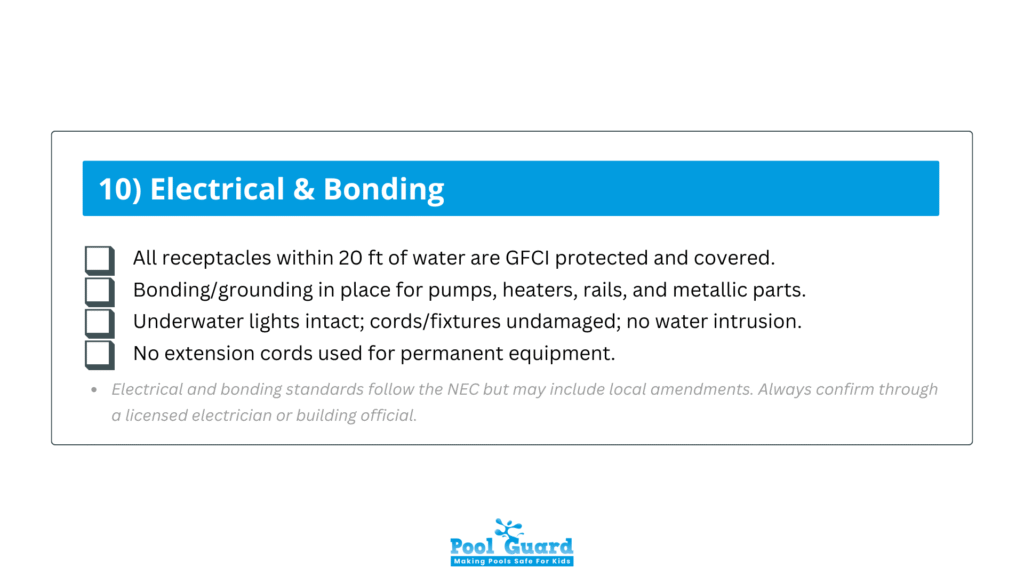
Tip: Electrical codes follow the NEC but may vary locally. Always confirm through a qualified inspector.
Consistent recordkeeping and staff training are your compliance backbone. The CDC’s Model Aquatic Health Code (MAHC) mandates daily logs and certifications for all public facilities — and even residential owners benefit from similar discipline.
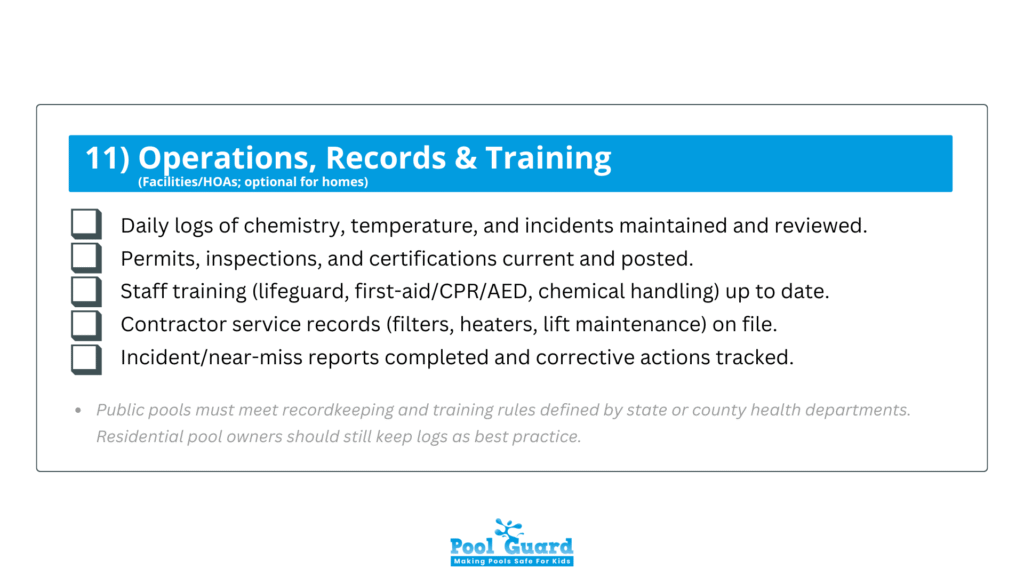
Tip: Public pools must maintain health-department logs; residential operators should follow this as best practice.
Pro tip: Digitize your logs-cloud records are easier to audit and preserve.
Most after-hours incidents occur when pools are left unsecured or toys remain visible. The National Drowning Prevention Alliance notes that nearby 70% of child drownings happen outside of planned swim times.

Tip: Consistent closing routines create habits that prevent tragedy.
Slides, splash pads, lazy rivers, and seasonal factors introduce unique hazards – from chemical imbalances to storm damage. Adapting your checklist ensures safety year-round.
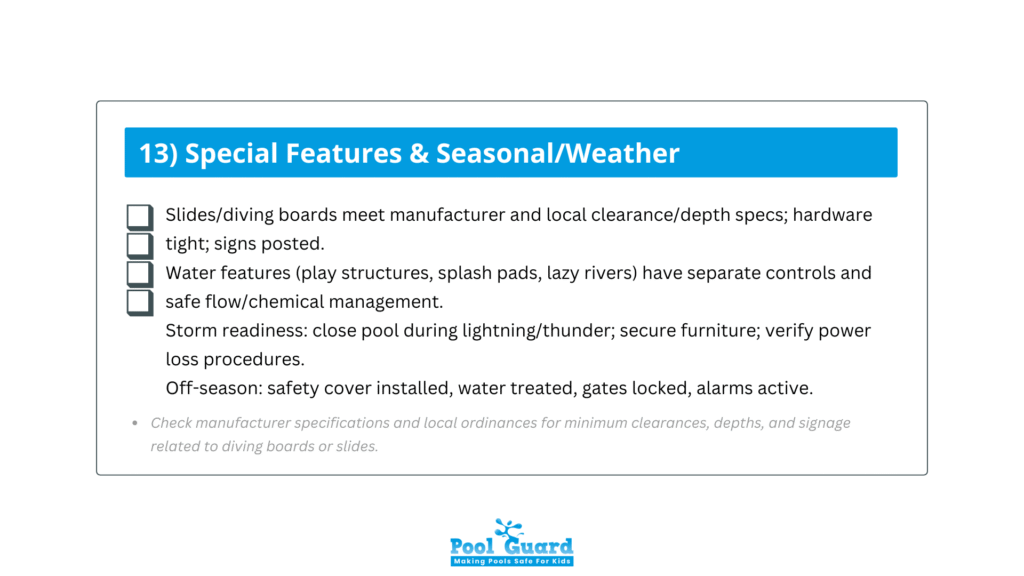
Tip: Check manufacturer manuals and local ordinances for slide or feature clearance requirements.
Pro tip: Add this section to your annual preseason inspection-especially in regions prone to hurricanes, lightning, or winter freezing.
Ready to put these tips into action? Then you should use pool safety equipment list to run through the essentials in minutes. Download Pool Guard’s pool safety checklist now and keep it handy for every swim session. It’s a quick way to make sure your pool area stays safe and well-maintained. Consistent checks help prevent accidents and give you peace of mind all season long.
A pool should be a place of joy – not risk. Following this 13-step pool safety checklist helps protect lives, maintain compliance, and preserve your investment. By combining clear pool safety rules with practical swimming pool safety tips, you can create a safe and enjoyable environment for everyone who uses your pool.
Whether you manage a hotel pool or your own backyard, safety starts with awareness and consistency. Review each section regularly, train your team or family, and perform ongoing inspections to ensure your swimming pool checklist remains up to date and effective.
Please fill out the form below with your information. Your local dealer will be notified about your inquiry.
Please fill out the form below with your information. Your local dealer will be notified about your inquiry.